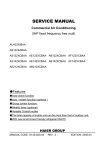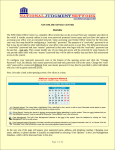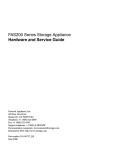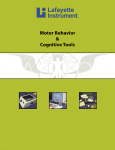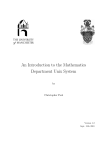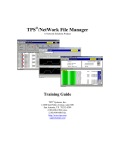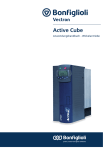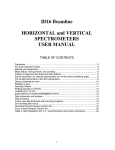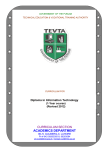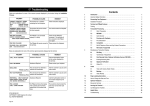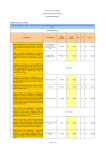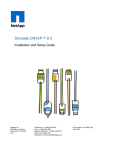Download Keynotes
Transcript
Computing Service Keynotes Volume 28 Number 6 June 2002 Fun... ...with a PDA Also in this Issue: Frequently asked questions Windows 2000:user status Yo r k We b s e r v e r u p g r a d e Mail server upgrade Vi r u s e s contents Volume 28, Number 6 From the Editor There's lots going on with YorkWeb at the moment - turn to page 11 for information on the server upgrade, page 12 for information of the University's Professional Development Strategy for Web Authors, and page 13 for an explanation of recent security changes in the YorkWeb filestore. ❖❖❖ As ever, viruses and virus hoaxes are a hot topic. On page 3 Phil Smailes details how to avoid prevalent current viruses, and writes about the latest hoax to affect many of our users. ❖❖❖ Finally, as a foil to the heavier technical side of life, our cover feature by Doug Moncur on page 8 reminds us that it's possible to have a bit of fun with technology. Joanne Casey Contents News in Brief Associates Database PC classrooms and study centres New staff training room Student Networked Services G/169 refurbishment Student leavers - expiry and extensions York welcomes Web Manager Closure of Dan Technology plc 1 1 1 1 1 2 2 2 News PC version of Uniras software for Windows 2000 Data Warehouse YIMS - finance project Online student feedback system New Spatial Datasets: LANDMAP and the Isle of Man ArcIMS: Internet Map Server Professional Development Strategy for Web Authors Mail server upgrade YorkWeb filestore: security changes New National PC Maintenance Contract suppliers Suspending mailing list subscriptions Implementation of the Library's new catalogues system 5 6 6 9 10 10 12 12 13 14 14 15 Feature articles Viruses Frequently asked questions User status on Windows 2000 Fun with a PDA YorkWeb server upgrade Mail server upgrade 3 4 7 8 11 12 Keynotes on the web Back copies of Keynotes can be found at: www.york.ac.uk/services/cserv/offdocs/keynotes/ Keynotes 2 PC classrooms and study centres New staff training room Brian Souter Brian Souter Brian Souter The Associates Database came into effect on Monday 6 May with all but a few departments having nominated a representative to enter details about their associate people. Although these representatives are now familiar with the system and aware of what is required, it is also important for other staff to understand what to do if they are responsible for a visitor or someone who is not employed directly by the University. Before approaching the Computing Service or Library, you should first contact your departmental representative and arrange to have the associate person registered in the database. This must be done twenty four hours in advance of contacting the Computing Service or Library. If you are in any doubt about who to contact then ask your departmental secretary or ring the Computing Service Information Desk on 3838. Once the perceived status and description of the person is available to Computing Service and Library staff then registration can proceed as normal with the applicant presenting themselves at either the Computing Service Information Desk or the Library Issue Desk. In the case of the Computing Service, the representative may also contact us by email or telephone to arrange the username. See www.york.ac.uk/univ/mis/cfm/ a s s o c _ r l l . y k u / assoc_procedure.htm for further information. At the time of writing we are unsure about our plans for upgrading the PC classrooms and study centres this summer. Our desire to upgrade all our rooms to Windows 2000 is unlikely to be matched by our funding. Pentium 3 PCs in L/050, G/022 and R/113 can be upgraded, but the older Pentium 2 PCs in G/ 169, L/117, D/114, A/D/270, V/ 058 and K/120 would have to be replaced. In addition to the PCs there is the cost of new furniture, security cuffs and decoration, as well as the desire to install air conditioning, security cameras and improved projection equipment. It all adds up to a huge cost for the University which is unlikely to be funded. Phasing in the work seems to be the only option but this creates the problem of providing a mixture of Windows 95 and Windows 2000 classrooms. We are consulting widely about how to proceed and will advertise our plans as soon as they are available. The next YIMS implementation of Finance and Student Records systems, plus an extensive staff development programme with PC based skills courses will demand a larger staff training facility than currently offered by the 6-seater facility in room H/ B40. It was therefore decided to provide an additional 12-seater facility and refurbishment work commenced in room W/218 in May. As part of the arrangement, both rooms will be centrally allocated space with bookings managed by the Timetabling Office in the Registry. The new facility in room W/218 will be equipped with 12 PCs plus one PC for the lecturer, video projection equipment and a printer. The new PCs are supplied by Viglen with Pentium 4 1.6GHz processors, 256Mb of memory, 20Gb hard drives, internal 250Mb Zip drives and Envy 15" flat screen display panels. The planned opening date of Monday 8 July is to be confirmed. G/169 refurbishment Goodricke 169 will close from 9am on Monday 10 June until Monday 5 August to allow for refurbishment and upgrade to Windows 2000. news in brief Associates Database Student Networked Services Robert Demaine The go-ahead has been given by the University to implement a pilot service which will bring Internet access via Ethernet to selected study bedrooms on campus from the start of next academic year. A total of 624 bedrooms located in James College (D, E and F blocks) and Halifax College (Ingram, Irwin, Lindley, Younger and Wood) will be included in the pilot which will offer access to mail, telnet, news and web services at an annual charge of £60 per year. The pilot service has been designed to be as simple as possible for users, so that anyone with a desktop system equipped with an Ethernet interface should be able to use it with the minimum amount of configuration effort. Documentation will be provided covering most popular desktop operating systems. Due to financial constraints it has not been possible to fund a post to provide direct support to users, however a one-year technician post has been created to build and manage the operation of the underlying network and server infrastructure. Further details of the pilot will be issued over the summer. Keynotes 3 news in brief Student leavers - expiry and extensions Brian Souter If you are a student leaver this year at the end of the Summer Term then your computer account will be set to expire on Saturday 13 July, the day after Degree Day. A countdown to this expiry date will be displayed when you log in. If you have a requirement to use your account beyond this date, or you are returning in the Autumn, you can apply for an extension. You will need to collect a form from our Information Desk and have it signed by your academic supervisor or Head of Department. If you are the owner of any other computer accounts then these will expire at the same time as your normal username. You should consider what to do with any society accounts BEFORE you leave as we may not be able to transfer ownership without your permission. All expired accounts are removed from our registration database automatically after one month, and all files are saved for one year. There is nothing for you to do in this respect, although you may wish to make your own copies of any important files or delete any unwanted ones. As with your other files, email folders will be saved for one year after expiry, but it would be useful if you tidied up your area and deleted any unwanted messages. At the very least, you should unsubscribe from any mailing lists. Once your computer account expires all email will be rejected unless you have set a forwarding address. Check out the Email Management section on our Electronic Information Desk: www-db.york.ac.uk/cgi-bin-auth/edesk_email. You will also need to give some thought to closing your print charge account. If your account is in credit then we will be happy to make a refund, if it is debit then you must pay the difference before leaving. Call in at our Information Desk once you are certain you will no longer need to do any printing. Yo r k w e l c o m e s W e b M a n a g e r William (Bill) Mackintosh has joined from City University, London where he held the post of Web Services Manager. Bill has an M.Sc. in Information Technology from the University of Glasgow and will be based in the Communications Office working with Kriss Fearon, Web Coordinator. Before moving to London, he was employed by the University of Oxford as a Senior Analyst/Programmer and ran a web site which was sponsored by Sun Microsystems Ltd. Bill’s commercial experience includes working for Marconi and IBM (UK). C l o s u r e o f D a n Te c h n o l o g y p l c Doug Moncur Dan Technology plc and associated subsiduary companies called in the receivers on 7 June and the companies have been wound up. All staff have been made redundant. No further orders should be sent to Dan Technology or Dan Peripherals. As the business has been closed, it is likely that any or all warranties are now invalid. If you own a Dan machine which has a maintenance contract with a third party supplier, such as Xenon, this will be unaffected. However, if the maintenance contract was placed via Dan there is a possibility that it may be invalid as Dan may not have paid the supplier for maintenance cover. More information will be circulated, via the Departmental Computing Officers’ mailing list, as it becomes available. Keynotes 4 Phil Smailes Cur rent Vi ruses The two viruses most prevalent on campus at the time of writing are W32/Flcss (aka Funlove, Fun Loving Criminal) and W32/Klez (variants A-H). Flcss It seems that Flcss is continuing to infect mainly, but not solely, via the installation of infected versions of messaging systems (such as Yahoo and MSN Messenger). Upon infection Flcss will attempt to infect any .exe, .scr and .ocx files on your local hard drive and on any network connections.If you do need these utilities, it is advisable to obtain them from known sources (Yahoo Messenger from Yahoo, MSN Messenger from MSN, etc): even these servers cannot be guaranteed virus free - once you have downloaded the files scan them with a virus scanner. viruses Viruses Klez & Elker n The Klez virus will normally arrive as an email attachment (as many viruses do) and once activated Klez will release another virus, W32/Elkern (one of variants A-C). Klez will proceed to use a built in email program to send itself out to email addresses in your address book, at the same time it will scan documents on your computer for email addresses and use these in the From: field (also known as email spoofing). This means that the recipient will assume that the infected email has come from a different source and not the host computer. When sending itself it will also attach a random file from the host computer, it will infect this file, but more importantly the file could contain confidential material. Another problem posed by Klez is that anti-virus email scanners may detect the virus and send a warning to the address that Klez forged, not to the host where the email originated. This then makes uninfected users believe that they may be infected. The Elkern virus dropped by Klez is designed to infect files on a computer without increasing their size, and some versions of Elkern, (such as Elkern-C), will seek out the on-access component of anti-virus software and attempt to disable it, thus allowing Elkern and Klez to operate without detection. What precautions can be taken? 1. 2. 3. 4. 5. 6. 7. 8. 9. Do not open any attachments directly from an email, instead save them to disk and scan them with a virus checker before opening them. Delete attachments with double extensions, e.g. somefile.txt.exe Be aware that some viruses (e.g. VBS/Potok-A) attempt to hide the second extension by using spaces, e.g. somefile.txt .exe If you need to send executable files as attachments, enclose them in a zip file. Try to send word documents as .rtf (Rich Text Files) because .doc files can be host to viruses and may be refused by email scanners. Scan any files you download from the Internet. Check your computer on a regular basis. If you receive an unexpected virus warning, do not forward it on, contact Infodesk (ext. 3838). If in doubt, contact Infodesk (ext. 3838) Hoax War nings Over the last few weeks a new virus hoax has been spreading. It alleges that jdbgmgr.exe is a virus and should be deleted. This is not true: this file is a required system file for Windows and must not be deleted. Please do not send the warning, or others of this type, to friends and colleagues. These messages cause problems by blocking email servers, and relying on users to do the damage to systems by means of advising the deletion of system files. You can check to see if a message you have been given is correct by visiting the Hoax and Scare section of the Sophos site (www.sophos.com/virusinfo/hoaxes/).. This will show you the ten latest warnings, and you can also check older warnings. If you are unsure what action to take, contact the Computing Service Information Desk (3838, [email protected]). Keynotes 5 faqs Frequently asked questions Aimee Phillips and Joanne Casey Windows 2000 Where should I be storing my files now I’m using Windows 2000? The H: drive is equivalent to the M: drive on supported Windows 95 connection (details of this can be found at: www.york.ac.uk/services/cserv/help/win2000/mh.htm). This drive is automatically mapped when you log in and has a 20mb allocation. If necessary, this can be increased to a maximum of 40mb. What are offline files? A useful feature of the Windows 2000 filestore is the offline facility. If you mark your H: drive as available offline, when a server is down you will be able to continue working on your files and synchronize the changes to the network version when the server is back online. When a file or folder is marked as being available offline the network version of the file is used as the default. If the server becomes unavailable, Windows 2000 synchronises the network files with a local cached copy. The local cached copy of the file can be modified then, when the server is reconnected, Windows 2000 synchronises the offline file with the network version. In the event of both the network version of the file and the local cached copied of the file being altered, Windows 2000 allows you to choose which file to keep, or to rename one file in order that both versions are kept. See www.york.ac.uk/services/cserv/help/win2000/offline.htm for full details. Where on Windows 2000 is the Zip & Unzip facility I used on Windows 95? The zip/unzip equivalent on Windows 2000 is Power Archiver, and can be installed by going to Start | Settings | Control Panel | Add/Remove Programs. Click on Add New Programs, select Power Archiver 2000 from the list, and click Add. How can I access a shared filestore on Windows 2000? Some users are experiencing problems when trying to access rented/shared filestores. We recommend that instead of using mapped drives to access your rented/shared filestore, you use Network Places. Details can be found at: www.york.ac.uk/services/cserv/help/win2000/network_places.html. Software purchases Which version of SPSS can I buy from the Computing Ser vice? SPSS 11 is now available to buy from the Computing Service for £5. This version will run on Windows XP, but not Windows 95. SPSS 10 is still available for Windows 95 users. How should I order software under the Campus Agreement? For users of supported Windows 95 PCs there is a charge of £5 for each set of disks (remember, one set can be used for several named machines). Users of unsupported PCs pay a one-off charge for each piece of software, equivalent to the charge under the Select software scheme. Send a Goods Demand and Charge Note to the Information Desk stating the software you require and the name(s) of the machine(s) that the software will be installed on. To comply with licensing conditions, it is essential that we are informed of all the machines on which you install Campus Agreement software - for more details see: www.york.ac.uk/ services/cserv/sw/ca_admin.htm. The Campus Agreement software is available to supported Windows 2000 PCs via the Add/ Remove Programs procedure. Keynotes 6 Rob Fletcher We have recently upgraded our licence for the Uniras products (from Advanced Visual Systems Inc.) to include the PC as a platform. In keeping with the policy of not upgrading the Windows 95 network, this version will only be deployed onto the Windows 2000 systems. If you wish to use Gsharp on a Windows95 system, then you will be able to mount it on your system locally. The software is licenced via the University FlexLm licence server nbroker.york.ac.uk. Thus, in order to run this software, you must be connected to the network. The software included in this release is: • • • software PC version of Uniras software for Windows 2000 Gsharp - professional graph plotting program fgl - Fortran graphics library agx - Toolmaster graphics library Visual C++ 6.0 and/or Digital Fortran 6.0 are the pre-requisites for programming using flg/agx, although other compilers have been used with some success. Gsharp is a good Windows implementation of the Unix variant available on IRIX and Solaris. It is a professional graph plotting system. It can create graphs in a large number of formats, ranging from simple bar/pie charts, scatter plots to 3D surface plots. It can read data in various formats, including Excel. An important feature is the ability to generate a script file once a final graph as been realised. This script when run will recreate the graph. Of course, you can edit this file to change the data source. It has an extremely flexible axis system. Example plots are shown below. Potential Vorticity Ground Model with Faults at the North Pole PV Units 3 2 1 Elevation 2,500 2,000 1,500 1,000 500 Fault lines definedGrid interpolated from XYZ from vector data points and fault vectors Topological scale 1 of 6 built-in shading scales O Profile on 90 E/W Source: UK Global Atmospheric Modelling Program Users wishing to install this software on their own systems should contact Rob Fletcher (3816, [email protected]) for further details. Keynotes 7 mis news Data Warehouse Nicola Normandale The Data Warehouse has now moved to its permanent home on a new server, and has been changed over to Interbase 6. We hope to have a backup server available soon, which should minimise service interuptions. Anyone who was using the Data Warehouse with MS Access will need to redefine their ODBC datasources - see www.york.ac.uk/services/cserv/help/admin.yrk/dwh/ib6access.htm. We recommend Access as the preferred method of linking to the Data Warehouse, as users of supported PCs are now able to get MS Access without having to buy a licence. For the Students and Space databases, we have provided template Access databases with the main tables already linked, and the main relationships (table joins) already set up. See www.york.ac.uk/services/cserv/help/admin.yrk/dwh/accessdwh.htm for details. Access courses are run termly by the Computing Service - see www.york.ac.uk/services/cserv/ training/essentials.htm. Those who currently use Paradox with the Data Warehouse can continue to do so, as Paradox will continue to be available. However, Paradox training by the Computing Service has been discontinued. YIMS – finance project Hamish McCardie Implementation Plan Following the signing of the contract with Agresso Ltd work has now been completed in drawing up a broad plan to implement the Agresso Business World system. A document entitled Yims Finance – Project Implementation Methodology (doc no T/YIMS/003/FIN – 025) was published on 17 May 2002. This document was distributed by e-mail to Heads of Departments, finance staff and key staff involved in the project. A copy of the document can be found on the York Web in the YIMS Finance area. In brief, the implementation has been broken into nine work streams as follows: Technical, Communications and Change Management, Reporting, Risk and Issues Management, Sales and Treasury, Nominal and Project, Purchasing and Inventory and Systems and Processes Training. Each work stream will have a dedicated leader who will be responsible for drawing up a detailed implementation plan for their respective work stream, agreeing this with Agresso and the project co-ordinator and drawing upon the skills and knowledge of other key staff from departments and finance to deliver that plan. The overall project will be co-ordinated by a project team consisting of the work stream leaders, Tim Franklin and the Agresso consultants. The project team will be located in a dedicated project office located within the finance department and will meet every Monday to discuss progress of the project. This project team will report via Keith Goodey – Project Sponsor to the YIMS Steering Group. “Go Live” The working date for go live is the end of period 6 (February 2003). Go live criteria is currently being drafted in conjunction with the Agresso Project plan. Agresso Team The Agresso team will consist of three main consultants – Mike Wilding – Project Manager, Keren Bass – Lead Consultant and Frank James – Consultant. Other specialist consultants will be used as necessary for areas such as Vat, Technical set-up etc. Keynotes 8 continued on opposite page Next steps The initial kick-off meetings took place on 20 May and the technical kick-off meeting took place on 24 May. These are designed to review which modules have been purchased, identify any interfaces with other systems, technical issues and to talk through the Agresso Implementation Methodology. The next step is for Agresso and the University to agree a detailed project plan. Training will then be given to the project team in one key area – the general ledger. This will enable the project team to understand how the system functions. Business Workshops will then take place at the end of June thereby giving Agresso a greater understanding of the University’s processes. This will enable Agresso to draft a “solution set-up document” and in conjunction with the project team and other key staff start to configure the system. This will take place over July and August. news continued from opposite page Systems and Process Training One of the key areas of the implementation is the training of staff. A training co-ordinator is currently being recruited to design and co-ordinate the training of all University staff over the next 10 months. The initial part of this will be to complete a training needs analysis for each department. The analysis will identify who needs training when and on which parts of the Agresso Business World system. Contact will be made shortly with the nominated departmental person to discuss this further. PC specifications Agresso will run on Windows 2000 PCs with the following specifications: Pentium III, 400MHz processor, 128Mb RAM, 8GB hard disk. User status on Windows 2000 Andrew Smith Windows 2000 allows a greater level of control over access to resources than Windows 95. One such resource is file access permissions. It is now possible to protect important system files from both accidental deletion and malicious damage by viruses. In the past users have had considerable problems with applications that they have installed themselves and these installations have updated important system libraries with earlier versions. This has caused many problems from stopping the PC booting to disabling common buttons within a window. Through the use of file system permissions and the control of access to other resources Windows 2000 allows for the assignment of many levels of privilege to users. We have simplified the generic model provided by Microsoft and have produced three main levels of privilege: • Student: no ability to install software or access to operating system configuration • Staff: can install software that conforms to Microsoft’s current software guidelines, and some system control • Staff Power User: full control over local PC, ability to install all software on the local machine, and some OS configuration These levels of privilege have been designed to protect both users and Computing Service staff. For example, it would be unwise to allow installation of software on public/student access PCs, as we would not be able to guarantee the integrity of these machines. The two levels of privilege for staff have been provided after consultation with Departmental Computing Officers on the ways in which their users work. We have found that the majority of staff users are able to work with the default privileges. Staff who are unable to install a particular package on their PC must first contact their DCO. If the DCO wishes, a request can be made to the Computing Service (via ETS) to increase the privilege of the user to Staff Power User. Keynotes 9 pdas Fun with a PDA ... Doug Moncur I’m known for my enthusiasms and eccentricities it’s one of the things that makes me who or what I am. I’ve had a Macintosh at home as my personal writing machine, and at the time it was a rewarding and productive experience. I like StarOffice and write a lot of my HTML documentation using it, and I’m gradually getting to grips with OpenOffice. A long time ago I was one of the first people in the Computing Service to have a dial up connection to an ISP: that was with a Mac, the ISP was Compuserve, and the year was 1992. I admit it. I’m a digital enthusiast. I also travel a lot to meetings, and carry a filofax that bulges at the seams, and is full of post-it notes with strange scribbles on them like ‘fx Krn re wwrth del’ or worse. Given that I spent 6 years studying Russian at high school and then went on to spend part of my university career studying in the medical sciences faculty it’s usually worse. My handwriting is pretty bad – almost a new concept in data security. So I’ve been looking for a portable note taker, diary manager and email drafter. And it has to be portable. I have a laptop and one arm is longer than the other to prove this. Laptops are great for taking away on overnight journeys to work on in your hotel room, or for taking home to work on something. They’re too big to work with comfortably on the train, the battery life isn’t the best, and then you usually have to lug the thing through the Underground in rush-hour London to the meeting, another train or Heathrow, and then knowing my luck, you have to do the same thing later that day coming back in the evening rush-hour. And of course you have a brief case with what seems to be 20kg of relevant papers and documentation. I exaggerate – it’s only usually around 7kg for even the worst meeting. So I’ve been thinking about the alternatives. My first idea was a Compaq Aero. A thing that looked like a laptop, had a keyboard, and used WinCE as an OS. Good product, instant on, ie no waiting for it to boot up and long battery life. The only problem was that Compaq had stopped making them. Then I considered an iPaq, Compaq’s pocket windows-based handheld. Definitely classy, but no keyboard. The same went for the various versions of the Palm pilot – remember I’ve handwriting to shame a drunken spider. Then one day I came across an online hardware disposal site where they were selling off new end of life Handspring Visors for around £50. A Handspring Visor is a Palm pilot clone and uses the Palm operating system. Again no keyboard, and this was £50 of my own money, but I decided to go for it. And I haven’t regretted it. It’s uncannily good. The PDA, personal digital assistant, or handheld computer, comes with software and a USB adapter to allow you to synchronise with data held on your PC. I set it up to synchronise with Outlook on my PC at home. Now Outlook is more than a mail client, it’s a contact manager, diary manager, task manager and has a note-taking capability built in. On my PC at home I have contact details for family and friends as well as colleagues, a copy of my diary with work and personal appointments, email messages about this and that, notes about things I’m interested in or working on, shopping lists; basically an electronic collection of all the junk in my filofax. Hit synchronise, and suddenly it’s all there on the PDA. Update a note on the PDA, add an appointment, extend the shopping list, synchronise in the evening when you get home, and again it’s all there on the PC. Admittedly I probably look a geek going round Sainsbury’s clutching a PDA, but is no worse than a set of scribbles on the back of an old bit of print out. And here, for me, is the killer. Not only can you update and create notes on the PDA while working on the train, you can write emails, get home, synchronise and they’re sitting in Outlook’s mail box ready to send. At first I thought the lack of the keyboard would be a problem – it isn’t. My PDA does come with handwriting Keynotes 10 Battery life isn’t a problem either. It does use them but a couple of Duracells seem enough for note taking and emails for a few weeks. If you were to use it continually that might not seem impressive, but like a filofax it’s having the data there that’s important – you probably only use the PDA for two minutes at a time at most. news recognition software that involves having to learn a whole new alphabet – it’s fun trying it out, but it doesn’t work for me. What it does come with is a little virtual onscreen keyboard that lets you peck messages out one character at a time using the stylus – it’s not that bad and definitely better than texting. On the other hand, with a keyboard and more memory you could draft a pretty substantial set of notes or documents. Third party keyboards are available for around £50 if you find you need one. So I’m in love. I thought it would be a useful toy, but after a couple of days of back to back meetings out of York I was convinced. If like me you live by email the ability to jot down a quick message while it’s fresh in your memory, and then send it when you get home, is the absoute killer application. The rest is pretty impressive as well. Some urls: Handspring - www.handspring.co.uk/ Palm Pilot - www.palm.com/uk/ Compaq iPaq - www.compaq.co.uk/products/ipaq/pocketpc/matrix.stm Widget - www.widget.co.uk Online student feedback system Fergus McGlynn The Internet is fast becoming a common tool for communication between University departments and their students. As web culture grows amongst both students and staff at York, the desire to exploit its vast potential increases. To this end, the University has decided to build a web-based system for collecting student feedback. The motivation for such a system comes from the expected saving in administration time (feedback form copying, distributing, collecting, processing will all be automated). Other benefits include the ability to conduct feedback at any time and as often as desired, the ability to conduct online tests (such as mid-term quizzes), potentially higher quality of feedback than most current paper-based systems (due to feedback not being conducted in a time restricted teaching session) and archived results being stored online (saving space and paper). The main perceived drawback of an online student feedback system is the response rate. Since it will be a computer based exercise, most departments who use the system will not be able to conduct their feedback sessions during class time. This opens up a quality versus quantity issue regarding student feedback. Current practice generally involves students being required to fill in forms during a lesson. Although this enforces a high response rate, it does not guarantee well thought out feedback. A ‘pilot’ online feedback trial (conducted last year) showed that many members of teaching staff enjoyed higher quality feedback. There are also a number of ways to help combat low return rates. I gave a talk discussing these issues at the Pathways to Excellence conference on 15 May as part of a session entitled Practical Aspects of Teaching and hope that this will promote some interest and discussion about webbased feedback in the wider academic community at York. Keynotes 11 gis New Spatial Datasets: LANDMAP and the Isle of Man Peter Halls The university has recently signed two new CHEST spatial datasets agreements, for the LANDMAP project data and for the Isle of Man government data. Both of these offer the university valuable spatial data for the cost of providing storage. The Isle of Man data is provided by the Government of the Isle of Man and currently comprises the entire topographic mapping for the island, address and street gazetteers. The Isle of Man Government have plans to add demographic datasets and other data to the datasets included in the agreement. There is no charge for this data but, in return, the Isle of Man Government do ask for formal notification of each project that would use the data and for the deposit of copies of reports, etc. that are based upon and/ or include extracts from the information provided. Please consult Peter Halls ([email protected]), the GIS Advisor, if you have a project for which this data might be appropriate. The LANDMAP project was funded by the JISC to enable wider exploitation of the satellite imagery purchased for the UK HE community through an earlier agreement in which the University of York participated. The primary goals of the project were the development of tools to ortho-register satellite imagery for the British Isles and to provide access to a seamless, joined up, version of the 47 LANDSAT and several hundred SPOT images that make up coverage of the islands. In addition, the project also obtained more recent LANDSAT imagery to complement the existing holdings. Ortho-registration of imagery entails computing the impact of variations in the distance from the camera to the subject in order to precisely control the registration of the image. For satellite imagery and aerial photography this requires use of a model of the ground surface elevation - a Digital Elevation Model (DEM). Unfortunately, no suitable DEM was available so the project created one using European Radar Satellite imagery. This DEM and the radar imagery used to create it, are also included in the LANDMAP project products. LANDMAP data may be used in any research and teaching that does not entail giving the data, or data closely derived from it, to a third party or for commercial consultancy. The LANDSAT and SPOT imagery held online at York will gradually be replaced with LANDMAP registered scenes, although we will retain a means of access to the raw data, in case this should this prove to be necessary for some future York project. In addition, and as they become available, the recent LANDSAT-7 scene equivalents will be added to the holding, giving coverage at an approximately 10 year interval. These data are stored in ArcInfo GRID format, ideal for use directly with both ArcInfo and ArcView and accessible to the PCI products. Enquiries regarding coverage not held online may be directed to Peter Halls, as above. Satellite imagery is suitable for spatially related studies in the sciences, social sciences and humanities - in any work where the environmental surroundings of a subject may be relevant. The data for the British Isles comprises 30m Thematic Mapper multi-spectral imagery (LANDSAT TM), 10 and ~20m Panchromatic imagery (SPOT and LANDSAT-7 Pan) and ERS Tandem Pair synthetic aperture radar imagery (SAR) and coverage includes Ireland, Orkney and Shetland in addition to mainland Britain and the Scottish Islands. There are no Ordnance Survey copyright issues with any of the Isle of Man or LANDMAP datasets, but these data are copyright. Details of any restrictions and of the required acknowledgement wording are provided in the Computing Service Hints and Tips web pages for GIS under Spatial Data. ArcIMS: Internet Map Server Peter Halls The Archaeology Data Service (Archaeology) and the Stockholm Environment Institute at York (Biology) have collaborated to fund the licence fee for the ArcIMS Internet Map Server product. IMS provides a range of tools for authoring and disseminating spatial information over the internet through an ordinary web browser interface. There are a range of capabilities, from simple publishing of spatial data - a map - through to interactive services where the user may use the interface to incorporate local information into an analysis or contribute modifications or updates to the spatial database, together with tools to manage the facilities delivered. At present, the license for this software is funded for two specific projects and so there is no wider access for other members of the university. If there are others in the university who think that they might benefit from using IMS they are invited to consult Peter Halls, GIS Advisor, Computing Service ([email protected]) to explore possibilities. Keynotes 12 John Byrne Early in the summer vacation the current YorkWeb server will be replaced by a new server cluster. The cluster consists of three identical UNIX systems which share the task of serving YorkWeb content to the internet. The cluster organises itself so that load is evenly distributed among its members, and will continue to work so long as at least one cluster member is running. This should provide a much more robust and responsive YorkWeb server environment. The cluster will also be running ColdFusion Server 5. New features Shortly after the rollout the following new features will be made available to to content providers: Enhanced access control Providers will be able to set access control on directories within their web sites. A simple web form will allow you to specify the target directory and the group(s) of users to be granted access. You will be able to select from a large list of standard groups - eg all staff, staff in your department, 2nd year undergraduates in your department, etc. You will also be able to define your own groups. yorkweb Yo r k W e b s e r v e r u p g r a d e Please note that directories with names ending .yrk, .ykc, and .yku will continue to provide protection against public access, however all such directories will behave as if they where .yku directories. This means that in any one browser session a user will always be challenged for authentication the first time they access a restricted document. Thereafter during the same session users will not be challenged for similarly restricted documents. Secure web transactions Providers creating pages with sensitive information - eg personal details, prompts for usernames and passwords, etc - will be able to use encryption facilities provided by the server cluster. Commonly referred to as SSL (Secure Sockets Layer), information flowing between the server and client is encrypted to help prevent eavesdropping on the internet. Advanced ColdFusion facilities ColdFusion developers will have access to selected advanced features including a range of additional tags and the ability to authenticate users in their scripts. Final decisions have yet to be made on availability of some of these features. How will the change af fect content providers? Anyone creating static web pages or using CGI scripts should be unaffected by the change. Absolute URLs to YorkWeb sites continue to be of the form www.york.ac.uk/... ColdFusion developers must make sure that scripts which make up an application and which use session variables are connected using relative URLs only (no www.york.ac.uk). This includes any static documents which might be part of the application. The reason for this is that session-aware applications must run on the same server box, and the only way to guarantee this in the clustered environment is to use relative URLs. The ColdFusion Studio 5 development environment will be made available to content providers over the summer vacation. Please note Studio 5 will not run on Windows 95. How will the change affect end users? Users following links or typing in URLs of the form www.york.ac.uk/..., will see the www replaced by www0, www1, or www2 in the browser’s location window: a user entering www.york.ac.uk/chemistry continued overleaf Keynotes 13 web and mail news continued from previous page in the location window might see it change to www1.york.ac.uk/chemistry. This is an artifact of the clustering process and in no way affects navigation of the site. Other changes The link-checker and usage statistics facilities will not be available for the start of the new service. Content providers can use Dreamweaver to check links within their sites. We hope that usage statics will reappear later in the summer, however usage data will continue to be recorded in the interim period. For more information on any of the above, please contact John Byrne in the Computing Service ([email protected], 3812). Professional Development Strategy for Web Authors William Mackintosh In November 2001, the Web Forum setup a working group to produce a report (www.york.ac.uk/coord/ docs/webforum.yrk/dwo-interim-report.pdf) on the role of Departmental Web Officers (DWOs). The report highlighted the varied and key function which DWOs fulfil. One of the first tasks of the newly appointed Web Manager (please see York Welcomes Web Manager on page 2) was to review the report and make a series of recommendations. The draft version of the Professional Development Strategy for Web Authors (www.york.ac.uk/coord/docs/webforum.yrk/dworole2.pdf) has highlighted a need to: 1. 2. 3. 4. Recognise the role of web authors through formal allocation of their time Develop a University-wide web strategy Review training available to authors Explore possible project management support for non-core web activities The strategy will be considered by Web Forum and Web Committee prior to submission to Information Committee. Mail server upgrade Mike Brudenell You may have noticed recently that the central Mail Service has become increasingly sluggish. This will be addressed over the Summer when the current computer is replaced and the server software upgraded. Because the use of email continues to grow we are having to ‘split’ the mail reading (IMAP) load over two computers: one is no longer sufficient. To make this work we need to direct people to use ‘their’ mail server when they want to read their messages. We are doing this by introducing personalised names for you to access ‘your’ mail server. The old single server “imap.york.ac.uk” will be withdrawn and instead there will appear to be a ‘personal’ server for each person, with their username as part of the computer name. (In reality each of these computer names will point to one of the two new machines.) For example the name of the ‘personal’ mail server for username “ozw1” will be “ozw1.imap.york.ac.uk” We are aiming to update these settings in the mail reading software we provide centrally. However if you use non-standard mail reading software, or have a machine on an unsupported connection, you will need to make this change for yourself. To help you we have set up these new ‘personalised’ mail server names already, all pointing at our existing mail server. So do please take a moment to alter the settings in your mail reading software now: it will save you having to do it later on this Summer. Keynotes 14 Yo r k W e b F i l e s t o r e : s e c u r i t y c h a n g e s In March this year a number of important security changes were implemented to give additional protection to resources held in the YorkWeb filestore. An unfortunate side-effect has been that new documents created in the TOP LEVEL DIRECTORY of a web site will not be visible to the outside world, and depending on the software being used, existing documents in the top level directory loose their visibility when edited. The reason for this is that new documents inherit the protection settings of their parent directories, and top level directories are protected against casual access. Unfortunately many file editors effectively create new documents during the editing process. Please note this only affects documents in a web site’s top level directory. How to make a document visible yorkweb John Byrne Supported Windows95 users Use a file browser to right-click the relevant file or directory, select properties from the drop-down menu, and display the SecureShare panel in the properties dialog. In the lower section of the panel set the following permissions: Owner: RWX Group: RX Other: RX Supported Windows 2000 users Use the NTapperm tool (t:\misc\apps\ntapperm.exe), select the file or directory and set the following permissions: Owner: Full control Group: read UNIX public: read UNIX users Use the chmod command to set 755 protection - eg chmod 755 abc.htm How to minimise the problem One way to minimise the problem is to place your documents in suitably protected subdirectories. For example create a subdirectory in your top level directory, give it the correct access-control settings (see previous section), then create/edit documents in the subdirectory - they will inherit the correct protections from their parent directory. Some documents, for example the welcome page, cannot easily be moved. One possibility is to work on a local copy of the document and use FTP to upload the document to the web site. All files and directories uploaded in this way will have the correct access-control settings. An FTP client is available on all supported platforms. We regret the inconvenience this has caused, and will be developing up a web-based tool which will allow site developers to set the correct protections. If you have any queries please contact John Byrne in the Computing Service ([email protected], 3812). Keynotes 15 news New national PC maintenance contract suppliers Doug Moncur You may remember that earlier this year Getronics, who had taken over the Getech maintenance contracts announced that they would pull out of the National Maintenance contract as of 31 July this year. The contract has been re-advertised, and ICM Support Services have been appointed in place of Getronics. The other existing supplier, Xenon, has had their contract renewed. Xenon’s prices are broadly what they were. ICM’s pricing is similar, and may offer some savings over Xenon’s prices for some classes of equipment, including standard desktop PCs. What happens next? If you are a Xenon customer you need do nothing until your contract becomes due for renewal in the normal way. If you placed your contract directly with Getronics, both ICM and Xenon will attempt to contact you to persuade you to place your business with them. If your maintenance contract has been placed through the Computing Service, we will write to you letting you know the cost of having the equipment maintained by both suppliers. We would hope to do this by late June. In order for the equipment to be maintained after 31 July you need to write back to us by 15 July saying with whom you want the equipment maintained and enclosing a goods demand and charge note for the next years maintenance. We will then place the equipment on contract with your nominated supplier. If we do not hear from you we will assume that the equipment is no longer to be maintained. I paid for 12 months cover with Getronics but only received 8 months worth Some Getronics customers are owed money as their contract has not run for the full year. Getronics have indicated that they will give refunds for the undischarged portions of contracts. When we receive the money from Getronics we will arrange to have it credited back to your departmental charge code in due course. This will take a bit of time to organise so you may not receive your refund until later this year. I have a new Viglen PC – am I affected? If you have bought, or are about to buy, a Viglen PC with 3 year’s onsite warranty this is not affected as the warranty is provided as part of the University’s contract for PCs. Likewise, if you have a Hewlett Packard laser printer which will be under 3 years old on 31 July 2002, and you have bought an HP support pack (onsite maintenance contract) with it you are not affected as your maintenance is provided by HP. Suspending mailing lists subscriptions Joanne Casey If you’re going to be away from the University for any length of time over the summer, it’s wise to suspend your subscriptions to any mailing lists you use. This avoids the potential problem of exhausting your mail quota and, since most mailing lists archive messages, you’ll be able to catch up on your return. For details of the commands used to suspend and resume your subscriptions, visit: University of York Lists Service - lists.york.ac.uk JiscMail - www.jiscmail.ac.uk/user-manual/summary-user-commands.htm Listserv - www.lsoft.com/info/manuals.asp Majordomo - www.greatcircle.com/majordomo/ Listproc - www.listproc.net/docs/usercard.html Keynotes 16 I m p l e m e n t a t i o n o f t h e L i b r a r y ’s n e w c a t a l o g u e s y s t e m Aleph, the new library management system, is planned to go live during the week beginning 15 July 2002. The final data extraction from our current system should be on 15 July and data conversion will take 3-4 days so that the actual live date will be 18 or 19 July. During this period the existing Dynix catalogue will be available for searching only. It will not be possible to carry out self service activities (renewals, recalls, advance bookings, etc). Issue and return of items will be done through the Aleph offline circulation software so that when we are ready to go live the information can be transmitted to the new system. We will be providing more detailed information, publicity and training nearer the time. Activities underway or required before going live include: • Library staff training Library staff are currently receiving “train the trainers” from Ex Libris, the company supplying the system. During June and July there will be concentrated training for all library staff on the various aspects of the system (public catalogue, circulation, cataloguing, acquisitions, serials, finance management, reports, etc). We are training staff from all libraries using the system: JBM, King’s Manor, Harrogate and York District Hospitals, York Minster, Borthwick Institute and the National Railway Museum (for which we have AHRB funding to add their stock to our catalogue over the next three years). • Conversion of all staff PCs to Windows 2000 Windows 2000 is required to run the Aleph staff software since support for Windows 95 in December 2001. • library news Chris Elwood Microsoft’s withdrawal of Conversion of all the catalogue ter minals in the libraries to Windows 2000 PCs to provide access to the Aleph web-based catalogue We are considering how many of these PCs should provide access only to the catalogue and how many could provide access also to electronic resources (e-journals, databases, etc.). This will be a balance between providing sufficient access for people just needing to look up items on the catalogue and improving access to electronic resources. We may get this wrong on day one so will monitor use and ask for feedback. • Design of the web catalogue The Web OPAC Development Group is working on the design of the public catalogue (OPAC). Initially we are making the minimum amount of changes to the catalogue as it comes “out of the box”. With a web catalogue there are so many possible options that we have decided to start by making very few changes and develop it in response to feedback during live use. • Data conversion and checking We have received the first test data converted from Dynix to Aleph and are checking it. When this is done, and any corrections to the conversion programme are made, the next data load will be of the full database to allow more in depth checking and testing. This process will be repeated until we are satisfied that the data is as good as possible. • Training and publicity for the new catalogue The Information Skills Review Group is planning publicity and the revision of guides. The new catalogue will also impact on the Library’s contribution to ILIAD and all our workbooks for ILIAD and other training sessions will need to be revised. New guides, publicity and training sessions will be available nearer the time. Information about this and the Library’s building works is available from Your New Look Library at www.york.ac.uk/services/library/newlook/. Chris Elwood is Head of Subject Services and Systems in the University Library. Keynotes 17 contact information Contacting the Computing Service Computing Service University of York Heslington YORK YO10 5DD Telephone: Direct dial: Fax: Email: www.york.ac.uk/services/cserv/ Inform ation Desk The Information Desk is your first point of contact with the Computing Service Telephone: ext 3838 Email: infodesk Open from 9am to 5.15pm Monday to Thursday, and 9am to 4.15pm Friday (may be closed for training Wednesdays 2pm3pm), for problem solving, advice and information, fault reporting, network connections, file restoration, sales, course bookings and user registration. Printed output can be collected from the lobby entrance which is open from 8am to midnight. Computing Ser vice Staff Director: Departmental Secretary: Mike Jinks Lorraine Moor 3801 3801 kmj1 lsm1 Head of Infrastructure: Head of User Services: Head of MIS: Head of Technical Services: Head of Systems: Operations Manager: Head of Networking: Information Officer: Robert Demaine John Illingworth Kay Mills-Hicks Doug Moncur Andrew Smith Brian Souter John Mason Joanne Casey 3808 3803 2101 3815 3809 3814 3813 3805 rld1 jji1 kmh8 dgm1 abs4 bs1 jrm13 jmc8 Linda Bailey Sue Bolton Mike Brudenell Lisa Burkinshaw John Byrne David Chambers Michael Clark Arthur Clune Steve Downes Ken Finch Rob Fletcher Kevin Gardner Chris Gowland Sarah Hall Peter Halls Sue Hodges Geoff Houlton Jenny Jackson 2100 Keynotes 18 (01904) 433800 (01904) 43 followed by ext no. (01904) 433740 [email protected] 3800 2102 3811 3818 3812 3742 3745 3129 3741 4452 3816 3739 3823 3827 3806 3839 gph2 4455 lcb6 sjb28 pmb1 ljb4 jcb1 dac6 mpc3 ajc22 sd21 kf1 rpf1 pkg4 cg1 seh11 pjh1 sh32 jj5 Chris Kilgour Fergus McGlynn John Marsden Darren Munday Nicola Normandale Phil O’Connell Aimee Phillips Tamsyn Quormby Colin Rea Chris Reece Peter Roberts Sam Scott Daniel Shelton Philip Smailes Simon Thompson Pete Turnbull Sam Vines Timothy Willson 4454 3822 3832 3821 4695 3825 3897 4347 3817 3807 3802 3817 4349 3833 3894 3804 3749 2123 crhk1 fam6 jpm1 dam6 ncn1 paoc1 amp11 tq1 cr9 car7 pdr1 svs2 ds23 pjrs1 sjt8 pnt1 sccv1 ftmw1





















